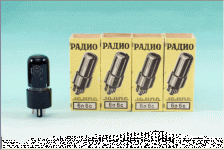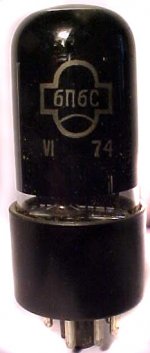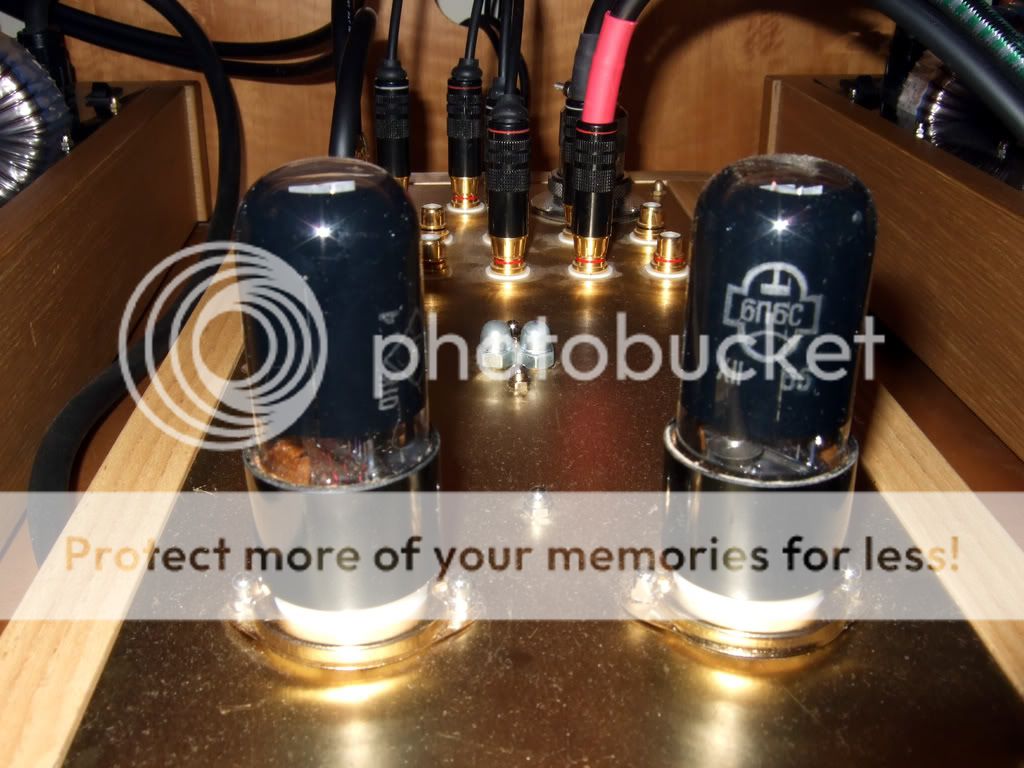No Salas I didnt use that tube...
Why not to try it?
If You have tube tester, before puting the tube into
preamp it would be nice.
*
maybe it have little bit different internal conn.
in that way
*
some EL84 russian,
have separated G3 from kathode (like EL34)
every electrode separate pin...
but this is better,
and should be connected to anode
*
Maybe the case in that 6V6 ?
*
please do not get me wrong
but your preamp shifting phase for 180deg
if You dont want OT
ADD some input transformer
*
Why not to try it?
If You have tube tester, before puting the tube into
preamp it would be nice.
*
maybe it have little bit different internal conn.
in that way
*
some EL84 russian,
have separated G3 from kathode (like EL34)
every electrode separate pin...
but this is better,
and should be connected to anode
*
Maybe the case in that 6V6 ?
*
please do not get me wrong
but your preamp shifting phase for 180deg
if You dont want OT
ADD some input transformer
*
I have good NATO NAVY tube tester. I will check it. It is Soviet 6V6.
Why this thing worrying with 180deg shift? Are you concerned about absolute phase? Every common cathode inverts. I can invert again by changing the polarity at the speaker inputs. Why you think I must do that only with a transformer and not otherwise?
Why this thing worrying with 180deg shift? Are you concerned about absolute phase? Every common cathode inverts. I can invert again by changing the polarity at the speaker inputs. Why you think I must do that only with a transformer and not otherwise?
A phase inversion can be restored anywhere in the chain. Phase distortion is more difficult to restore and carries impulse response implications. As it is, it has bandwidth in the hundreds of kHz. You prefer some transformer there so to narrow bandwidth more?
Our LPs and CDs have random absolute phase, I remind you.
I disagree in ''basic technical design goal'', its just a decision. It must be known in multi way multi amp systems, and taken account for. Would be a cancellation hazard in reinforcement. Where things must be standard and anybody can hook up whatever without knowing more. And they always hit the reverse button on the desk if something sounds thin. No utilization problem in a personal steady home system with a known inversion that I can see.
Better or same is relevant, but ''adequate'' is certain. Its about personal philosophy, that is why we do DIY. ABX listening, HEC amp 1ppm distortion science has enough logical data to lough on tube DIY anytime if likes. So its a personal matter why we like something like an exotic pre amp with power tubes in line duty in whatever style...
It works totally quiet on 95dB speakers with 28dB amp as it is grounded. Itself contributes an additional 15dB. It is referenced to chassis, it does not go through it. It uses copper foil sub star points that meet fixed with a security bolt at the copper chassis referenced master star.
Our LPs and CDs have random absolute phase, I remind you.
I disagree in ''basic technical design goal'', its just a decision. It must be known in multi way multi amp systems, and taken account for. Would be a cancellation hazard in reinforcement. Where things must be standard and anybody can hook up whatever without knowing more. And they always hit the reverse button on the desk if something sounds thin. No utilization problem in a personal steady home system with a known inversion that I can see.
Better or same is relevant, but ''adequate'' is certain. Its about personal philosophy, that is why we do DIY. ABX listening, HEC amp 1ppm distortion science has enough logical data to lough on tube DIY anytime if likes. So its a personal matter why we like something like an exotic pre amp with power tubes in line duty in whatever style...
It works totally quiet on 95dB speakers with 28dB amp as it is grounded. Itself contributes an additional 15dB. It is referenced to chassis, it does not go through it. It uses copper foil sub star points that meet fixed with a security bolt at the copper chassis referenced master star.
OK, whatever...
seems that easyer and less demanding design is always better...
if that is exotic, what is preamp with for instance 10Y tube,
or some older DHT good sounding tube...
*
I didnt mean to underesimated the design,
just oposite, like I noted in some posts before,
*
even had a personal experiments in pentode preamps
6V6, 6L6, EL34...
*
seems that easyer and less demanding design is always better...
if that is exotic, what is preamp with for instance 10Y tube,
or some older DHT good sounding tube...
*
I didnt mean to underesimated the design,
just oposite, like I noted in some posts before,
*
even had a personal experiments in pentode preamps
6V6, 6L6, EL34...
*
In ''exotic'' concept I don't mean mine (said in whatever style) but all the big tubed rare line or RIAA stuff made one off that ain't commercial.
The Japanese school sounds anemic to me by the way. Low swing niche curved silver opt etc has a butterfly sound that I find too fragile. I like the French school of sound, then the English and Italian. Also Serbia has very good tone, very melodic, yet with a bit of German like discipline.
The Japanese school sounds anemic to me by the way. Low swing niche curved silver opt etc has a butterfly sound that I find too fragile. I like the French school of sound, then the English and Italian. Also Serbia has very good tone, very melodic, yet with a bit of German like discipline.
Zoran said:
*
even had a personal experiments in pentode preamps
6V6, 6L6, EL34...
*
Please give a URL for your stuff if online, we would all like to admire. I personally favor Serbian tube designs a lot.
I don't understand why you saw a challenge. You talk very learned on the subject, I wanted to see some other ideas. Especially yours. Always happy to learn, discuss. So simple.
Countries have their sound based on mainstream culture and designers that influenced local audio history. Many times a general national tone has been referred as a school in audio jargon.
No intentions in the way you thought.
All the best.
Salas.
Countries have their sound based on mainstream culture and designers that influenced local audio history. Many times a general national tone has been referred as a school in audio jargon.
No intentions in the way you thought.
All the best.
Salas.
Countries have their sound based on mainstream culture and designers that influenced local audio history. Many times a general national tone has been referred as a school in audio jargon.
This is like in the US during the 70s and 80s we had the concept of the westcoast sound and the east coast sound typified by JBL and Boston Acostics respectively. There are of course exceptions to all such generalizations.
It would be very interesting I think to become more familiar with the audio design philosophies which predominate in various other cultures. Given the huge difference in culture, the arts and music in places like Japan v.s. the Western European cultures I could well imagine that different aspects of audio would be valued more or less highly in the different countries.
mashaffer said:
This is like in the US during the 70s and 80s we had the concept of the westcoast sound and the east coast sound typified by JBL and Boston Acostics respectively. There are of course exceptions to all such generalizations.
It would be very interesting I think to become more familiar with the audio design philosophies which predominate in various other cultures. Given the huge difference in culture, the arts and music in places like Japan v.s. the Western European cultures I could well imagine that different aspects of audio would be valued more or less highly in the different countries.
Take a look at what the Japanese are listening to at the extreme high end and you will see it is mostly WE and what would otherwise often if not always typify West Coast Sound i.e. JBL, Altec Lansing, Langevin, Brook, RCA cinema hardware, and a reinterpretation of the old Jensen speakers (now Onken). Not all of these are from the West Coast, but all are synergistic with that sound. Oddly enough despite denigrating it for decades I now understand my tastes run in exactly the same direction as those fellows, and my system would be right at home in a typical Japanese listening room. (My tastes always really tended in that direction, I was just too ignorant to realize it. I might have scored some good JBL kit at a time when it was under appreciated, now of course it's way too late.. I had to pay $$$.)
The West Coast vs East Coast Sound thing goes way further back to sometime in the late 1950's and probably originates with the original AR acoustic suspension speaker systems. FWIW As a New Englander I prefer the left (west) coast sound..
Very interesting points of view  i found a 60' study, in french, where the question of choosing the monitoring loudspeakers in the ORTF house was deliberated : At this time , musical consideration was in second order after the "speach" sound because of the need to improve the voice of France worldwide
i found a 60' study, in french, where the question of choosing the monitoring loudspeakers in the ORTF house was deliberated : At this time , musical consideration was in second order after the "speach" sound because of the need to improve the voice of France worldwide 
The study was comparing the sound of the french language vs english / spanish / german / italian : and concluding to a more accurate quality in medium / high spectrum needed against boomy bass ... so even 50 years later, the "french sound" remains in narrow 8' to 10' speakers , 12' are professional , 15' were undiscovered except in movies whith Altec A7
except in movies whith Altec A7 
The study was comparing the sound of the french language vs english / spanish / german / italian : and concluding to a more accurate quality in medium / high spectrum needed against boomy bass ... so even 50 years later, the "french sound" remains in narrow 8' to 10' speakers , 12' are professional , 15' were undiscovered
 except in movies whith Altec A7
except in movies whith Altec A7 Re: how about this?
Thank you very much foboleyns, this is interesting.
Kind regards,
Darius
Originally #32posted by foboleyns
hello everyone!
I am sorry for my badly english (japanese is OK ), but here is a special preamp circuit for 6V6 ,maybe interesting.
Thank you very much foboleyns, this is interesting.

Kind regards,
Darius
- Home
- Amplifiers
- Tubes / Valves
- 6V6 line preamp


